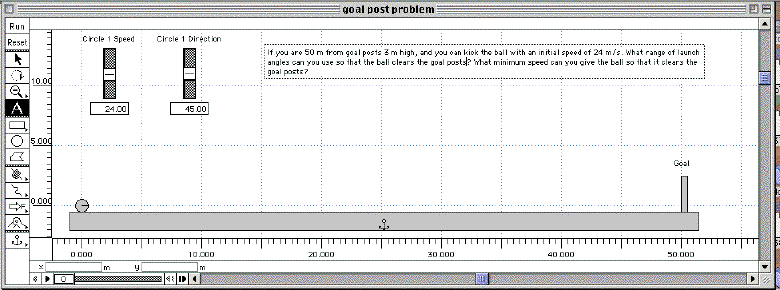Physics Simulation
The Place Kicker Problem


 [Lab Index]
[Lab Index]
BHS
-> Staff
-> Mr. Stanbrough ->
AP Physics -> Kinematics
-> this page
Ask your instructor for values of "v" and "d" for the following
problem:
If you are d meters from goal posts 3 m high, and you
can kick the ball with an initial speed of v m/s. What range of
launch angles (in degrees) can you use so that the ball clears the
goal posst? What minimum speed can you give the ball so that it
clears the goal posts?
Here is a method for setting up an Interactive Physics
simulation to solve this problem:
The Simulation:
- Open the Interactive Physics program.
- Set the simulation
accuracy to "Accurate".
- Select "Rulers" and "Coordinates" from the Workspace
submenu of the View Menu to help with positioning of the
objects.
- Increase the size of the window horizontally so that the
objects in the simulation can be as large as possible.
- Make the "ball".
- Create
a circle object (
 )
to represent the ball.
)
to represent the ball.
- Open the
Properties Window for the ball, and set its position to (0,
0).
- Decide on a method
to set the speed and direction of the ball, and implement
it.
- Make the "ground" and "goal posts".
- Zoom out
(
 )
a couple of times so that you can see at least "d" meters in
the window.
)
a couple of times so that you can see at least "d" meters in
the window.
- Create a rectangle object (
 )
to represent the "ground".
)
to represent the "ground".
- Resize the "ground" if necessary and drag it so that the
"ball" rests on it. (You may need to zoom in (
 )
on the ball to see this better.)
)
on the ball to see this better.)
- Anchor
(
 )
the ground.
)
the ground.
- Create a rectangle object to represent the goalposts. Use
the rulers and coordinates to size and position it.
|
This is an example of a simulation designed to solve the
"Place Kicker Problem". The initial speed and direction of
the ball are set by controls.
|

|
Running the Simulation:
Run the simulation, and
when you have results that you are happy with, use the text tool
( )
to add your name, and print it out. Before you turn it in, compare
your simulation results with your analytical solution. If they don't
agree, see what you can do about reconciling the difference.
)
to add your name, and print it out. Before you turn it in, compare
your simulation results with your analytical solution. If they don't
agree, see what you can do about reconciling the difference.


 [Lab Index]
BHS
-> Staff
-> Mr. Stanbrough ->
AP Physics -> Kinematics
-> this page
[Lab Index]
BHS
-> Staff
-> Mr. Stanbrough ->
AP Physics -> Kinematics
-> this page
last update July 20, 2000 by JL
Stanbrough
 )
to represent the ball.
)
to represent the ball. )
a couple of times so that you can see at least "d" meters in
the window.
)
a couple of times so that you can see at least "d" meters in
the window. )
to represent the "ground".
)
to represent the "ground". )
on the ball to see this better.)
)
on the ball to see this better.) )
the ground.
)
the ground. 